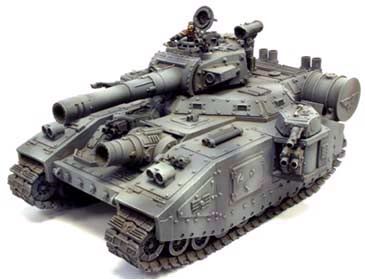In 2002 Forgewold released the first of their Baneblade varients, three years after getting the license to make them from Armorcasat. Rules were included in Imperial Armour 1, which would be published in 2003. Forgeworld casts of the Baneblade offered significant improvement in detail over their Armorcast predecessors. Additionally, the organization structure of Forgeworld coupled with the quality of the Imperial Armor books made use of the Baneblade more common, this wider use by gamers would ultimately lead to the production of the largest Games Workshop plastic kit in their history 5 years later.
In September of 2004 THQ launched Dawn of War, a real time strategy game including multiple factions for play form the Warhammer 40,000 universe. In 2005 the 'Winter Assault' expansion pack brought Imperial Guard into the game as a playable faction. Fittingly, the Baneblade was included in the Imperial Guard arsenal as the super weapon.
In conjunction with the launch of Apocalypse in October of 2007, Games Workshop introduced the first plastic Baneblade kit. This kit marked a significant improvement for the company in terms of how its models were made, the Baneblade was the first Games Workshop kit to be made using injection molding, allowing for never before seen detail in their kits like hollow exhausts and gun barrels.
Following the release of plastic Baneblade kits, Forgeworld stopped sales of their Baneblade and Stormsword variants in July of 2010 due to loss of sales following the release of the plastic Baneblade and Shadowsword kits.
Cheers,
Tallarn





Thanks for taking the time to inform us and give us something to reminice about. Much appreciated!
ReplyDeleteWonderful stuff, Tallarn: thanks. Surprised you didn't note the different FW variants, though...
ReplyDeleteThanks for all the work in this post (and it's first part).
ReplyDeleteThi smade my day reading the history behind the model.
Ron